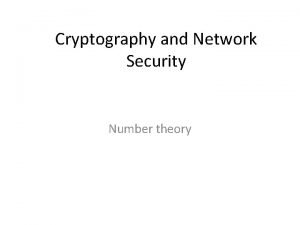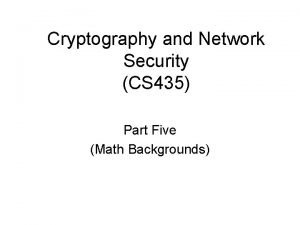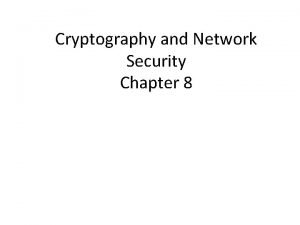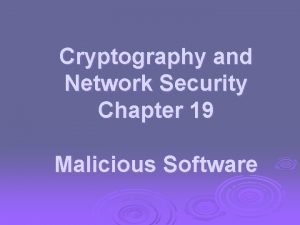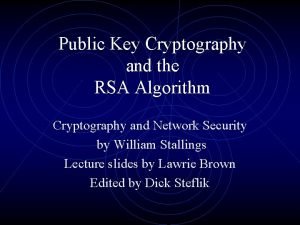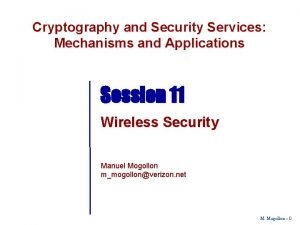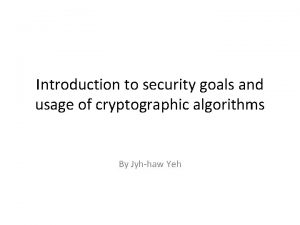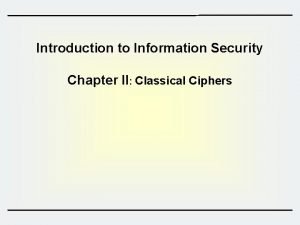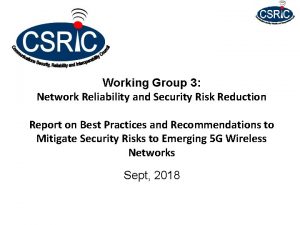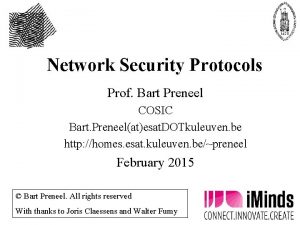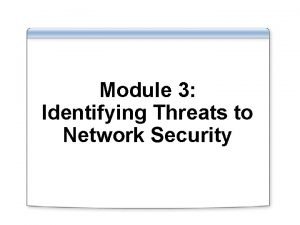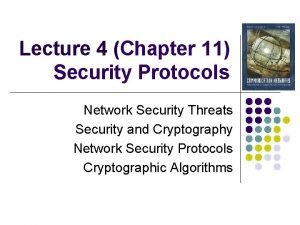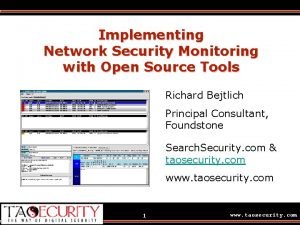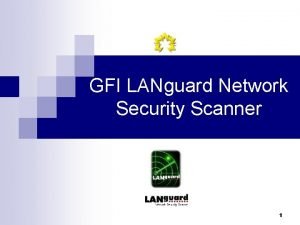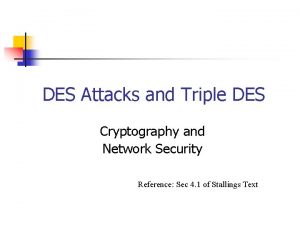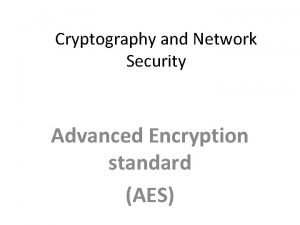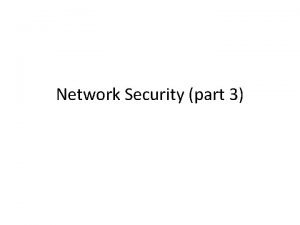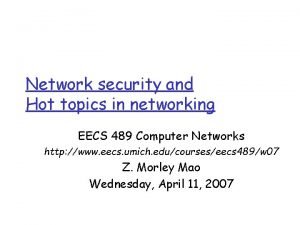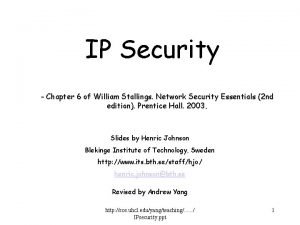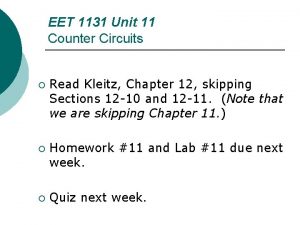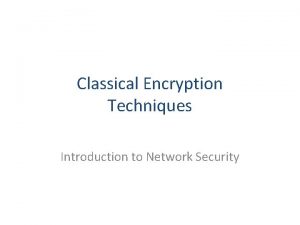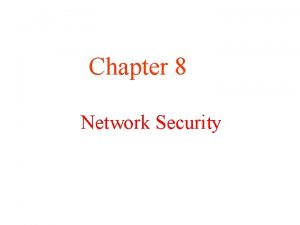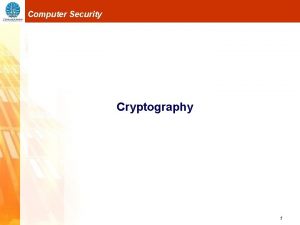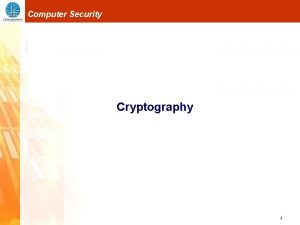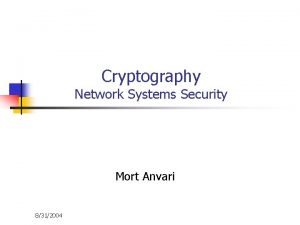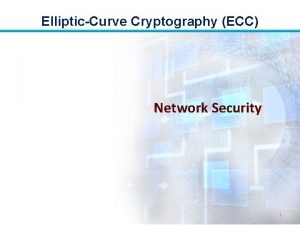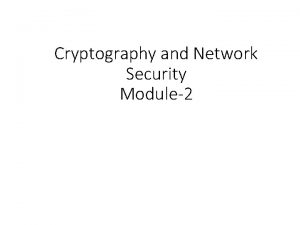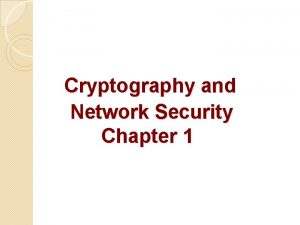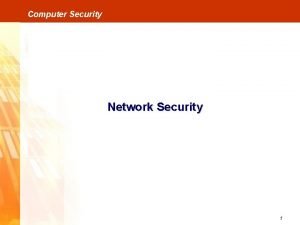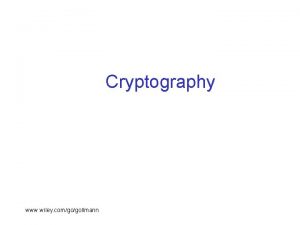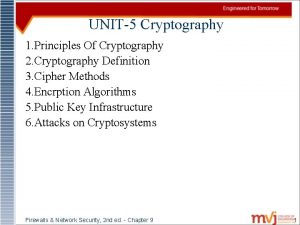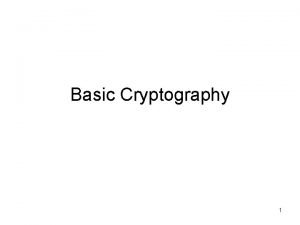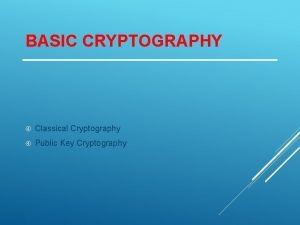Chapter 8 Network Security Cryptography Introduction to Cryptography





























































- Slides: 61

Chapter 8 Network Security

Cryptography • • • Introduction to Cryptography Substitution Ciphers Transposition Ciphers One-Time Pads Two Fundamental Cryptographic Principles

Need for Security Some people who cause security problems and why.

An Introduction to Cryptography The encryption model (for a symmetric-key cipher).

Transposition Ciphers A transposition cipher.

One-Time Pads The use of a one-time pad for encryption and the possibility of getting any possible plaintext from the ciphertext by the use of some other pad.

Quantum Cryptography An example of quantum cryptography.

Symmetric-Key Algorithms • • • DES – The Data Encryption Standard AES – The Advanced Encryption Standard Cipher Modes Other Ciphers Cryptanalysis

Product Ciphers Basic elements of product ciphers. (a) P-box. (b) S-box. (c) Product.

Data Encryption Standard The data encryption standard. (a) General outline. (b) Detail of one iteration. The circled + means exclusive OR.

Triple DES (a) Triple encryption using DES. (b) Decryption.

AES – The Advanced Encryption Standard Rules for AES proposals 1. The algorithm must be a symmetric block cipher. 2. The full design must be public. 3. Key lengths of 128, 192, and 256 bits supported. 4. Both software and hardware implementations required 5. The algorithm must be public or licensed on nondiscriminatory terms.

AES (2) An outline of Rijndael.

AES (3) Creating of the state and rk arrays.

Electronic Code Book Mode The plaintext of a file encrypted as 16 DES blocks.

Cipher Block Chaining Mode Cipher block chaining. (a) Encryption. (b) Decryption.

Cipher Feedback Mode (a) Encryption. (c) Decryption.

Stream Cipher Mode A stream cipher. (a) Encryption. (b) Decryption.

Counter Mode Encryption using counter mode.

Cryptanalysis Some common symmetric-key cryptographic algorithms.

Public-Key Algorithms • RSA • Other Public-Key Algorithms

RSA An example of the RSA algorithm.

Digital Signatures • • Symmetric-Key Signatures Public-Key Signatures Message Digests The Birthday Attack

Symmetric-Key Signatures Digital signatures with Big Brother.

Public-Key Signatures Digital signatures using public-key cryptography.

Message Digests Digital signatures using message digests.

SHA-1 Use of SHA-1 and RSA for signing nonsecret messages.

SHA-1 (2) (a) A message padded out to a multiple of 512 bits. (b) The output variables. (c) The word array.

Management of Public Keys • Certificates • X. 509 • Public Key Infrastructures

Problems with Public-Key Encryption A way for Trudy to subvert public-key encryption.

Certificates A possible certificate and its signed hash.

X. 509 The basic fields of an X. 509 certificate.

Public-Key Infrastructures (a) A hierarchical PKI. (b) A chain of certificates.

Communication Security • • IPsec Firewalls Virtual Private Networks Wireless Security

IPsec The IPsec authentication header in transport mode for IPv 4.

IPsec (2) (a) ESP in transport mode. (b) ESP in tunnel mode.

Firewalls A firewall consisting of two packet filters and an application gateway.

Virtual Private Networks (a) A leased-line private network. (b) A virtual private network.

802. 11 Security Packet encryption using WEP.

Authentication Protocols • • • Authentication Based on a Shared Secret Key Establishing a Shared Key: Diffie-Hellman Authentication Using a Key Distribution Center Authentication Using Kerberos Authentication Using Public-Key Cryptography

Authentication Based on a Shared Secret Key Two-way authentication using a challenge-response protocol.

Authentication Based on a Shared Secret Key (2) A shortened two-way authentication protocol.

Authentication Based on a Shared Secret Key (3) The reflection attack.

Authentication Based on a Shared Secret Key (4) A reflection attack on the protocol of Fig. 8 -32.

Authentication Based on a Shared Secret Key (5) Authentication using HMACs.

Establishing a Shared Key: The Diffie-Hellman Key Exchange The Diffie-Hellman key exchange.

Establishing a Shared Key: The Diffie-Hellman Key Exchange The bucket brigade or man-in-the-middle attack.

Authentication Using a Key Distribution Center A first attempt at an authentication protocol using a KDC.

Authentication Using a Key Distribution Center (2) The Needham-Schroeder authentication protocol.

Authentication Using a Key Distribution Center (3) The Otway-Rees authentication protocol (slightly simplified).

Authentication Using Kerberos The operation of Kerberos V 4.

Authentication Using Public-Key Cryptography Mutual authentication using public-key cryptography.

E-Mail Security • PGP – Pretty Good Privacy • PEM – Privacy Enhanced Mail • S/MIME

PGP – Pretty Good Privacy PGP in operation for sending a message.

PGP – Pretty Good Privacy (2) A PGP message.

Web Security • • Threats Secure Naming SSL – The Secure Sockets Layer Mobile Code Security

Secure Naming (a) Normal situation. (b) An attack based on breaking into DNS and modifying Bob's record.

Secure Naming (2) How Trudy spoofs Alice's ISP.

Secure DNS An example RRSet for bob. com. The KEY record is Bob's public key. The SIG record is the top-level com server's signed has of the A and KEY records to verify their authenticity.

Self-Certifying Names A self-certifying URL containing a hash of server's name and public key.

Steganography (a) Three zebras and a tree. (b) Three zebras, a tree, and the complete text of five plays by William Shakespeare.
 Wireless security in cryptography
Wireless security in cryptography Introduction to network security and cryptography
Introduction to network security and cryptography Introduction to cryptography and network security
Introduction to cryptography and network security Introduction to cryptography and network security
Introduction to cryptography and network security Cryptography and network security 6th edition
Cryptography and network security 6th edition Number theory in cyber security
Number theory in cyber security Firewall base layer
Firewall base layer Authentication in cryptography and network security
Authentication in cryptography and network security Intruders in cryptography
Intruders in cryptography Primitive root in cryptography and network security
Primitive root in cryptography and network security Cryptography and network security 6th edition pdf
Cryptography and network security 6th edition pdf Pearson cryptography and network security
Pearson cryptography and network security Source
Source Cryptography and network security 4th edition
Cryptography and network security 4th edition Euler's theorem in cryptography and network security
Euler's theorem in cryptography and network security Multiplicative inverse
Multiplicative inverse Digital signature in cryptography and network security
Digital signature in cryptography and network security Gcd(1970,1066)
Gcd(1970,1066) Pgp in cryptography and network security
Pgp in cryptography and network security Euler's theorem in cryptography and network security
Euler's theorem in cryptography and network security Malicious software in cryptography and network security
Malicious software in cryptography and network security Rsa algorithm in cryptography and network security
Rsa algorithm in cryptography and network security Security private
Security private What is osi security architecture
What is osi security architecture Security guide to network security fundamentals
Security guide to network security fundamentals Electronic mail security in network security
Electronic mail security in network security Security guide to network security fundamentals
Security guide to network security fundamentals Security guide to network security fundamentals
Security guide to network security fundamentals Cryptography security services
Cryptography security services Security services in cryptography
Security services in cryptography Pigpen
Pigpen Introduction to cryptography
Introduction to cryptography Nyu cryptography
Nyu cryptography Birthday attack
Birthday attack Roman emperors cipher
Roman emperors cipher Explain about visa international security mode
Explain about visa international security mode Cnss security model คือ
Cnss security model คือ Security policy and integrated security in e-commerce
Security policy and integrated security in e-commerce Software security touchpoints
Software security touchpoints 5g americas
5g americas Wireless security definition
Wireless security definition Palo alto networks certified network security engineer
Palo alto networks certified network security engineer Network security protocols
Network security protocols Network security essentials 5th edition pdf
Network security essentials 5th edition pdf Network security design and implementation
Network security design and implementation Module 3: information and network security
Module 3: information and network security What is message authentication code
What is message authentication code Network security protocols
Network security protocols Network security monitoring nsm open systems
Network security monitoring nsm open systems Gfi languard network scanner
Gfi languard network scanner Triple des meet in the middle attack
Triple des meet in the middle attack Aes in network security
Aes in network security Modern network security
Modern network security Network security services nss
Network security services nss Network security topologies
Network security topologies Interesting topics in network security
Interesting topics in network security Kr
Kr Unit 11 homework: network security
Unit 11 homework: network security Ec-council network security administrator
Ec-council network security administrator Network security greensboro
Network security greensboro Classical encryption techniques in network security
Classical encryption techniques in network security Bro network security monitor
Bro network security monitor














